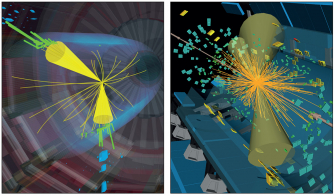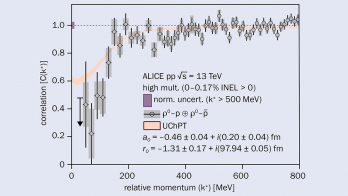
Image credit: ALICE Collaboration.
Hadrons carrying heavy flavour (charm or beauty quarks) are produced in initial hard scatterings and their production rates in the absence of nuclear effects can be calculated using perturbative QCD. Therefore, they are well-calibrated probes that provide information on the nuclear effects at play in the initial and final state of the collision, such as the modification of the parton-distribution functions in nuclei or the energy loss from rescattering between the produced particles, as well as into the dynamics of the heavy-ion collision.
The centrality dependence of prompt D-meson production in p–Pb collisions was studied by the ALICE collaboration by comparing their yields in p–Pb collisions for various centrality classes with those of binary scaled pp collisions at the same centre-of-mass energy via the nuclear modification factor, QpPb, evaluated as the ratio of these quantities. QpPb is equal to unity in the absence of nuclear effects. The D-meson QpPb in collisions classified in percentiles of the energy of slow neutrons detected by the ZNA calorimeter at very large rapidity in the Pb-going direction (figure 1, above) are consistent within uncertainties with unity, i.e. with binary collision scaling of the yield in pp collisions, independent of the geometry of the collision. There is no evidence for a modification of the spectrum shape for pT ≥ 3 GeV/c in the initial or final state of p–Pb collisions.
The D-meson yields in p–Pb collisions were also studied as a function of the relative charged-particle multiplicity at mid-rapidity and at large rapidity (Pb-going direction), by evaluating the yields in multiplicity intervals with respect to the multiplicity integrated ones, Y/〈Y〉. While with QpPb, particle production was examined in samples of 20% of the analysed events, this observable explores events from low to extremely high multiplicities corresponding to only 5% (1%) of the analysed events in p–Pb (pp) collisions. These measurements are sensitive to the contribution of multiple-parton interactions in pp and p–Pb collisions. The D-meson yield (figure 1, right) increases with a faster-than-linear trend as a function of the charged-particle multiplicity at mid-rapidity. This behaviour is similar to that of the measurements in pp collisions at 7 TeV. By contrast, the increase of the D-meson yields as a function of charged-particle multiplicity in the Pb-going direction is consistent with linear growth as a function of multiplicity. EPOS3 calculations describe the p–Pb results within uncertainties. The results at high multiplicity are better reproduced by the calculation including a viscous hydrodynamical evolution of the collision.
Charmed-meson measurements in p–Pb collisions have revealed intriguing features. The ALICE collaboration is looking forward to the higher-statistics p–Pb data sample to be collected by the end of 2016, which will allow for higher-precision measurements, bring information on the initial state of heavy-ion collisions and provide further constraints to small-system dynamics.








